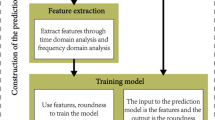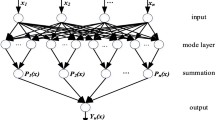Abstract
Ball mills are extensively used in the size reduction process of different ores and minerals. The fill level inside a ball mill is a crucial parameter which needs to be monitored regularly for optimal operation of the ball mill. In this paper, a vibration monitoring-based method is proposed and tested for estimating the fill level inside a laboratory-scale ball mill. A vibration signal is captured from the base of a laboratory-scale ball mill by using a ± 5 g accelerometer. Features are extracted from the vibration signal by using different transforms such as fast Fourier transform, discrete wavelet transform, wavelet packet decomposition, and empirical mode decomposition. These features are given as input to an artificial neural network which is used to predict the percentage fill level inside the ball mill. In this paper, the predicted fill level obtained by using different features are compared. It is found that the predicted fill level due to features obtained after fast Fourier transform outperforms other transforms.









Similar content being viewed by others
References
Mishra BK (2003) A review of computer simulation of tumbling mills by the discrete element method Part II—practical applications. Int J Miner Process 71:95–112
Hosseini P, Martins S, Martin T, Radziszewski P, Boyer F (2011) Acoustic emissions simulation of tumbling mills using charge dynamics. Miner Eng 24:1440–1447
Pérez-Alonso C, Delgadillo JA (2012) Experimental validation of 2D DEM code by digital image analysis in tumbling mills. Miner Eng 25:20–27
Behera B, Mishra BK, Murty CVR (2007) Experimental analysis of charge dynamics in tumbling mills by vibration signature technique. Miner Eng 20(1):84–91
Liddel KS, Moys MH (1988) The effects of mill speed and filling on the behavior of the load in a rotary grinding mill. J South Afr Inst Min Metall 88(2):49–57
Zeng Y, Forssberg E (1994) Application of vibration signal measurement for monitoring grinding parameters. Mech Syst Signal Process 8(6):703–713
Kolacz J (1997) Measurement system of the mill charge in grinding ball mill circuits. Miner Eng 10(12):1329–1338
Tang J, Zhao L, Zhou J, Yue H, Chai T (2010) Experimental analysis of wet mill load based on vibration signals of laboratory scale ball mill shell. Miner Eng 23:720–730
Si G, Cao H, Zhang Y, Jia L (2009) Experimental investigation of load behavior of an industrial scale tumbling mill using noise and vibration signature techniques. Miner Eng 22:1289–1298
Su Z, Wang P, Yu X, Lv Z (2008) Experimental investigation of the vibration signal of an industrial tubular ball mill: monitoring and diagnosing. Miner Eng 21:699–710
Das SP, Das DP, Behera SK, Mishra BK (2011) Interpretation of mill vibration signal via wireless sensing. Miner Eng 24:245–251
Makokha AB, Moys MH (2012) Multivariate approach to online prediction of in-mill slurry density and ball load volume based on direct ball and slurry sensor data. Miner Eng 26:13–23
Gonzalez GD, Miranda D, Casali A, Vallebuona G (2008) Detection and identification of ore grindability in a semiautogenous grinding circuit model using wavelet transform variances of measured variables. Int J Miner Process 89:53–59
Lu M, Kang Y, Han X, Yan G (2014) Soft sensor modeling of mill level based on deep belief network. In: Proceedings of 26th Chinese control and decision conference (CCDC), pp 189–193
Tang J, Zhao L, Yue H, Yu W, Chai T (2011) Vibration analysis based on empirical mode decomposition and partial least square. Procedia Eng 16:646–652
Radziszewski P, Tarasiewicz S (1993) Modelling and simulation of ball mill wear. Wear 160:309–316
Ahmadzadeh F, Lundberg J (2013) Application of multi regressive linear model and neural network for wear prediction of grinding mill liners. Int J Adv Comput Sci Appl 4(5):53–58
Singh V, Banerjee PK, Tripathy SK, Saxena VK, Venugopal R (2013) Artificial neural network modelling of ball mill grinding process. J Powder Metall Min 2(2):106
Ertunc HM, Ocak H, Aliustaoglu C (2013) ANN- and ANFIS-based multi-staged decision algorithm for the detection and diagnosis of bearing faults. Neural Comput Appl 22(Suppl 1):S435–S446
Zhong B, MacIntyre J, He Y, Tait J (1999) High order neural networks for simultaneous diagnosis of multiple faults in rotating machines. Neural Comput Appl 8:189–195
Li B, Zhang P, Mi S, Liu P, Liu D (2013) Applying the fuzzy lattice neurocomputing (FLN) classifier model to gear fault diagnosis. Neural Comput Appl 22:627–636
Das S, Das DP, Sarangi CK, Bhoi B (2018) Estimation of hydrogen flow rate in atmospheric Ar:H2 plasma by using artificial neural network. Neural Comput Appl. https://doi.org/10.1007/s00521-018-3674-z
Huang C, Zhang H, Huang L (2019) Almost periodicity analysis for a delayed Nicholson’s blowflies model with nonlinear density-dependent mortality term. Commun Pure Appl Anal 18(6):3337–3349. https://doi.org/10.3934/cpaa.2019150
Huang C, Zhang H (2019) Periodicity of non-autonomous inertial neural networks involving proportional delays and non-reduced order method. Int J Biomath 12(2):1950016. https://doi.org/10.1142/S1793524519500165
Huang C, Yang Z, Yi T, Zou X (2014) On the basins of attraction for a class of delay differential equations with non mono-tone bistable nonlinearities. J Differ Equ 256:2101–2114
Huang C, Su R, Cao J, Xiao S (2019) Asympotically stable high orderneutral cellular networks with proportional delays and D operators. Math Comput Simul. https://doi.org/10.1016/j.matcom.2019.06.001
Proakis JG, Manolakis DG (1999) Digital signal processing, 3rd edn. Prentice-Hall India, New Delhi
Mallat SG (1989) A theory for multiresolution signal decomposition: the wavelet representation. IEEE Trans Pattern Anal Mach Intell 11(7):674–693
Peng ZK, Chu FL (2004) Application of the wavelet transform in machine condition monitoring and fault diagnostics: a review with bibliography. Mech Syst Signal Process 18:199–221
Ting W, Guo-Zheng Y, Bang-Hua Y, Hong S (2008) EEG feature extraction based on wavelet packet decomposition for brain computer interface. Measurement 41(6):618–625
Labate D, Foresta FL, Occhiuto G (2013) Empirical mode decomposition Vs. Wavelet decomposition for the extraction of respiratory signal from single-channel ECG: a comparison. IEEE Sensors J 13(7):2666–2674
Huang NE, Shen Z, Long SR, Wu MC, Shih HH, Zheng Q, Yen NC, Tung CC, Liu HH (1998) The empirical mode decomposition, and the Hilbert spectrum for nonlinear and nonstationary time series analysis. Proc R Soc Lond A 454:903–995
Author information
Authors and Affiliations
Corresponding author
Additional information
Publisher's Note
Springer Nature remains neutral with regard to jurisdictional claims in published maps and institutional affiliations.
Rights and permissions
About this article
Cite this article
Nayak, D.K., Das, D.P., Behera, S.K. et al. Monitoring the fill level of a ball mill using vibration sensing and artificial neural network. Neural Comput & Applic 32, 1501–1511 (2020). https://doi.org/10.1007/s00521-019-04555-5
Received:
Accepted:
Published:
Issue Date:
DOI: https://doi.org/10.1007/s00521-019-04555-5




